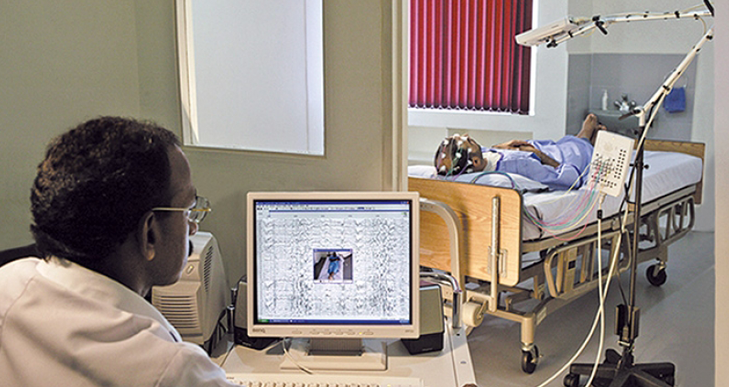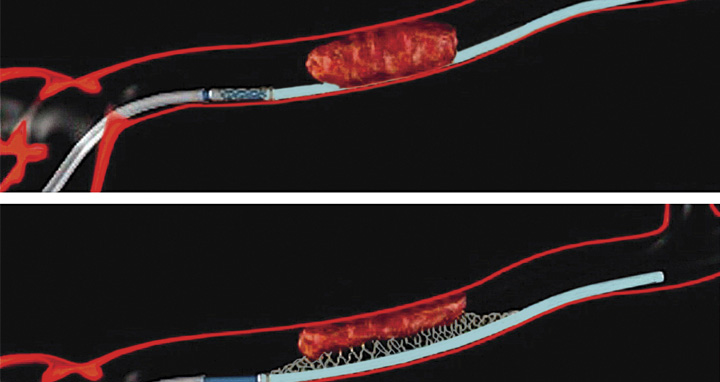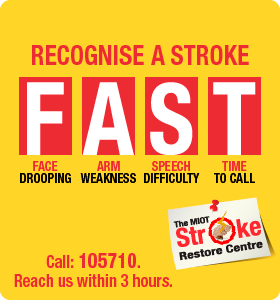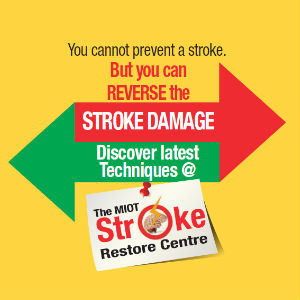Overview
The Department of Neurology and Neurophysiology at MIOT International offers patients of all age groups end-to-end care for diseases related to the brain, spinal cord, muscles and nerves.
Out-patient Services
The department caters to patients with a wide spectrum of ailments, ranging from headache, stroke, epilepsy, vertigo to neck and back pain, Parkinson’s disease, memory problems and dementia. It also manages neurological problems in children such as cerebral palsy, developmental delay, mental retardation and behavioural disturbances. Special therapeutic procedures such as botox injections are also undertaken.
Neuro Physiology lab
The Department has a well equipped electrophysiology lab where tests are conducted by an experienced electrophysiology technician. State of the art EEG with video coupling are available to assess patients with difficult to diagnose seizure pattern The neurophysiology laboratory assesses the spinal cord, peripheral nerves and the muscles, using top-of-the-line electrophysiological equipment for diagnosis. Additionally, the laboratory helps in assessing patients with disc disease involving the neck as well as the lower back. These assessments pinpoint the exact location of the disease.

The modalities for the electrophysiological investigations done here include 16-channel EEG, nerve conduction study of all four limbs, brachial plexus study, carpal tunnel study, facial nerve study, blink reflex study, H-reflex study, dermatomal SEP, sympathetic skin response, electromyography, repetitive nerve stimulation, autonomic function tests, VEP, BAER , SSEP, EEG , sleep study ( including polysomnography) and needle EMG study.
Emergency services
The department caters to emergencies such as Stroke, myasthenia gravis (an autoimmune neuromuscular disease), Guillain-Barré syndrome (a disorder affecting the peripheral nervous system), epilepsy, cerebral venous thrombosis (CVT) and acute demyelinating encephalomyelitis (ADEM).
Patients in the throes of epileptic convulsions are immediately given drugs to control seizures and resuscitated, if they are in shock. Ventilator therapy is started immediately if required. An emergency CT scan and EEG are also done to diagnose the cause of the convulsions.
Comprehensive stroke care
MIOT International has a 6-bedded, fully equipped, acute stroke / neuro medical ICU with a dedicated round-the-clock stroke team which is a group of a neurologists, interventional neuroradiologists, neurosurgeons and critical-care specialists. The neuro medical /stroke ICU handles all emergencies including ischemic strokes, haemorrhagic strokes, subarachnoid haemorrhage, venous thrombosis, epileptic convulsions and more. Its state-of-the-art facilities include those for intra-arterial thrombolysis, mechanical clot extraction, aneurysm coiling, continuous EEG monitoring etc.
When the stroke patient is brought in, emergency imaging such as CT scan of the brain or an MRI diffusion study or a CT angiography is done and treatment started immediately. Recombinant tissue plasminogen activator (rtPA) is used for patients who have ischemic strokes. If necessary, an emergency thrombectomy is done. Recombinant factor VII is given to patients with intracerebral haemorrhage. Endovascular coiling or stenting is done for patients who have subarachnoid haemorrhages due to aneurysm rupture.
To know more about SROKE Management at MIOT Hospitals with Biplane CathLab please visit
Rehabilitation
Neurological disorders such as stroke, brain tumour, head injury, transverse myelitis, spinal cord injury, meningoencephalitis etc. can result in disability. These patients are rehabilitated through physiotherapy, occupational therapy and speech therapy.
Botox therapy is given to patients with twisted posture (dystonia) of the neck or limbs, oromandibular dystonia, blepharospasm, hemifacial spasm and severe spasticity, who do not respond to other modalities of treatment this is an outpatient procedure.
Treatments & Procedures
- Neuro-endovascular stenting for acute ischemic strokes
- Embolisation of brain aneurysm / AVM / fistulae
- Angioplasty and stenting for stroke prevention
- Head and Neck tumour embolization
- Embolization for epistaxis
- Embolization for chronic subdural Hemorrhage
- Embolization for spinal cord vascular malformations
- Paediatric / congenital CNS vascular malformations
- Flow diverter / Web device for aneurysm
- Facial Hemangioma embolization
Outpatient
- Headache
- Epilepsy
- Neck and back pain
- Vertigo
- Old strokes
- Speech disturbances
- Memory problems / Dementia
- Limb weakness
- Gait and coordination disturbances
- Parkinson’s disease
- Facial palsy
- Nerve entrapment syndromes
- Anxiety neurosis
- Somatization disorders
Paediatric
- Cerebral palsy
- Developmental delay
- Mental retardation
- Behavioural disturbances
Emergency
- Stroke
- Myasthenia gravis
- Guillain Barre syndrome
- Epilepsy
- Cerebral venous thrombosis (CVT)
- Acute demyelinating encephalomyelitis (ADEM)
Management of Chronic Conditions:
- Botox therapy
- Rehabilitation
Treatments & Procedures
- Neuro-endovascular stenting for acute ischemic strokes
- Embolisation of brain aneurysm / AVM / fistulae
- Angioplasty and stenting for stroke prevention
- Head and Neck tumour embolization
- Embolization for epistaxis
- Embolization for chronic subdural Hemorrhage
- Embolization for spinal cord vascular malformations
- Paediatric / congenital CNS vascular malformations
- Flow diverter / Web device for aneurysm
- Facial Hemangioma embolization
Outpatient
- Headache
- Epilepsy
- Neck and back pain
- Vertigo
- Old strokes
- Speech disturbances
- Memory problems / Dementia
- Limb weakness
- Gait and coordination disturbances
- Parkinson’s disease
- Facial palsy
- Nerve entrapment syndromes
- Anxiety neurosis
- Somatization disorders
Paediatric
- Cerebral palsy
- Developmental delay
- Mental retardation
- Behavioural disturbances
Emergency
- Stroke
- Myasthenia gravis
- Guillain Barre syndrome
- Epilepsy
- Cerebral venous thrombosis (CVT)
- Acute demyelinating encephalomyelitis (ADEM)
Management of Chronic Conditions:
- Botox therapy
- Rehabilitation
MIOT Stroke Restore Center
We all know of or have seen the devastating effects of a stroke – the paralysis, the disfigurement, the transformation of an independent person into someone confined to bed and reliant on a caregiver for all their needs. Yet this doesn’t have to be – with Mechanical Thrombectomy, introduced for the first time in India by the MIOT Stroke Restore Center stroke, victims can regain their faculties within hours and damage caused can be reversed. Patients return to a full, productive life, provided he or she is treated at the right center, within 3 hours.
The MIOT Stroke Restore Center is on standby, 24-7-365 for just this reason. It combines sophisticated training, experience, cutting-edge diagnostic tools and the latest internationally adopted procedures, to treat all types of stroke. Manned by a world-class team comprising Neurosurgeons, Neurologists, Neuro Endovascular Specialists, Intensivists, dedicated Nurses, and others, our focus is not to limit damage, but reverse it completely, wherever possible.

MIOT Stroke Restore Center Emergency number – 105710
Online Enquiry
For any enquiries on STROKE please fill out the form below, one of our executive will get in touch with you shortly.
How does a stroke happen?

During a stroke, a clot that has formed within your blood vessels blocks blood flow to the critical centers of your brain. Deprived of oxygen, the cells in these centers die. This can cause permanent damage and even leave you in a vegetative state, permanently dependent on a caregiver.
You can also have a stroke due to a bleed in your brain caused by a blood vessel that has ruptured. These, however, are not very common.
Regardless of the cause of the stroke, it is vital that blood flow is restored as quickly as possible in order to prevent or limit permanent damage. The ‘golden window’ when treatment is most effective is 3 – 5 hours from the start of symptoms. So it is critical that patient is taken to a center with a stroke unit, such as the MIOT Stroke Restore Center, which is manned and equipped to treat all types of strokes.
Treating for complete recovery
Most centers in India use clot busting medication, which is administered intravenously, to dissolve the clots and restore blood flow. While it is effective in small blood vessel clots, it has been found to dissolve only 40% of the blocks found in larger vessels. This often results in poor outcomes despite timely treatment.
Clots in larger vessels can also be cleared by inter arterial thrombolysis, where the Interventional neuro-radiologist delivers the clot dissolving medication directly into the block, using a catheter. It works faster, but carries the risk of bleeding.
At the MIOT Stroke Restore Center, rather than take a chance, our specialists intervene to remove the clot through a Mechanical Thrombectomy, the latest globally adopted treatment. Twice as effective, our patients recover the faculties lost during a stroke within hours of the procedure.
Mechanical Thrombectomy – no room for doubt
Mechanical Thrombectomy is the latest and most effective treatment for clearing blocks in large vessels. During the intricate procedure, which is performed in the NeuroCath lab, a special device called a stent retriever (a tiny metal cage) is used to trap the clot and extract it completely without open surgery. It restores blood flow quickly, making it more effective and safe when dealing with larger blocks. It is today the preferred treatment at leading stroke centers across the world.

Dedicated Care for Successful Recovery
- Detailed imaging from CT scans with advanced CT per fusion studies and angiography give our specialists complete information about the location, severity and areas affected by the stroke, before they begin treatment.
- Our expert Neuro Endovascular specialist performs the procedure in the state-of-the-art NeuroCath Lab which is equipped with special software for neuro applications that aid precision and safety during the intricate procedures.
- Patients then recover in a dedicated Stroke ICU unit, under the care of an experienced team of intensivists, neurologists, neurosurgeon and specially trained nurses.
It is this complete, specialised care that allows us to give our patients the best chance for a productive, active life – even after a stroke.

You could be at risk!
Anyone can have a stroke at any time. However, your chances increase based on your family history, age and lifestyle.
Lifestyle factors that increase your risk are
- High blood pressure
- High cholesterol
- Diabetes
- Smoking
- Poor diet and lack of exercise
- Being overweight or obese, (especially around the abdomen)
- Heart disease
- Drinking too much alcohol
There’s no way to predict who could be struck down by stroke. However adjustments to your lifestyle, such as managing risk factors with the help of your doctor, maintaining a healthy weight and quitting smoking can reduce your risk. Finally, have regular check-ups and don’t ignore the warning signs.
Know the Warnings Signs & Act F.A.S.T.
There’s no way to predict a stroke. However there are definite signs which can be easily recognized.
You can do this by remembering F.A.S.T.

F – Face. Ask the person to smile. Does ones side of the face droop?
A – Arms. Ask the person to raise both arms. Does one arm drift downward?
S – Speech. Ask the person to repeat a simple phrase. Is his speech slurred, incoherent or strange?
T – Time. If you’ve observed any of these signs, call the MIOT Stroke Restore Centre at 105710.
A Stroke Survivor Case Study
Warning signals missed. Valuable time lost. Precious brain cells lost.
Would Mr. Ravi ever recover from these wrong turns in his Stroke treatment?
When Mr. Ravi, 62 yrs, a diabetic with blood pressure, developed mild weakness in the left side of his body, his family did not realise that a stroke was setting in. They took him to the nearest Nursing home which neither had the facilities nor understood the need for quick treatment. They advised a CT scan at a scanning center, 8 kms away. Mr. Ravi got weaker, drowsy & finally lost consciousness at the center. It was only then that his family panicked & rushed him to MIOT International. Why did they wait? Like most of us, they were unaware that a Stroke can damage our brain completely in a very short time, without correct treatment.
How did Mr. Ravi go from ‘weak’ to ‘unconscious’?
A clot had stopped blood flow to Mr. Ravi’s brain, and it first affected oxygen supply to the brain cells controlling movement and his movements got weak. As time passed, it affected cells controlling consciousness, which made him drowsy and then unconscious. Without timely treatment, a stroke affects various centres in our brain reducing us to an irreversible, vegetative state.
At MIOT, advanced imaging gives the complete picture
Mr. Ravi got to MIOT quite late – it had been 3 hrs since his symptoms had started. However, our specialists used advanced CT scans with perfusion studies and angiography, available at very few centers, to get the correct status. In just 8 minutes they knew the location and extent of the block and could predict areas of further damage if blood flow to his brain wasn’t restored quickly. This prompt and invaluable data allowed them to draw up the correct Treatment Plan despite the time lost.
Mechanical Thrombectomy, an advanced procedure used by leading centres worldwide with a 79% success rate, was performed to reverse damage.
Racing against time to restore blood flow
Mr. Ravi was shifted quickly to our dedicated NeuroCath lab, where our renowned Neuro Endovascular specialist got to work. Within minutes, he had accessed the blocked blood vessel. Then, using a special microcatheter and a stent retriever, he trapped and removed the clot causing the block. Blood flow restored, our patient was transferred to the dedicated Stroke Unit for further treatment.
A remarkable recovery
Mr. Ravi’s recovery was indeed remarkable. At the end of one week, 40% movement had returned to the side affected by his stroke. He was discharged and continued physiotherapy at home under instructions from doctors at MIOT. Two weeks later, he had made a 90% recovery and was up and about! A result rarely seen among such severely affected patients.
“I didn’t think I would walk again! Thank God they finally decided to bring me to MIOT. You have to have skill, experience & facilities to treat a Stroke case effectively. Tomorrow, if I should ever see another person having a Stroke, I have no doubts on what to do. I learnt it the hard way…” – Mr. Ravi




